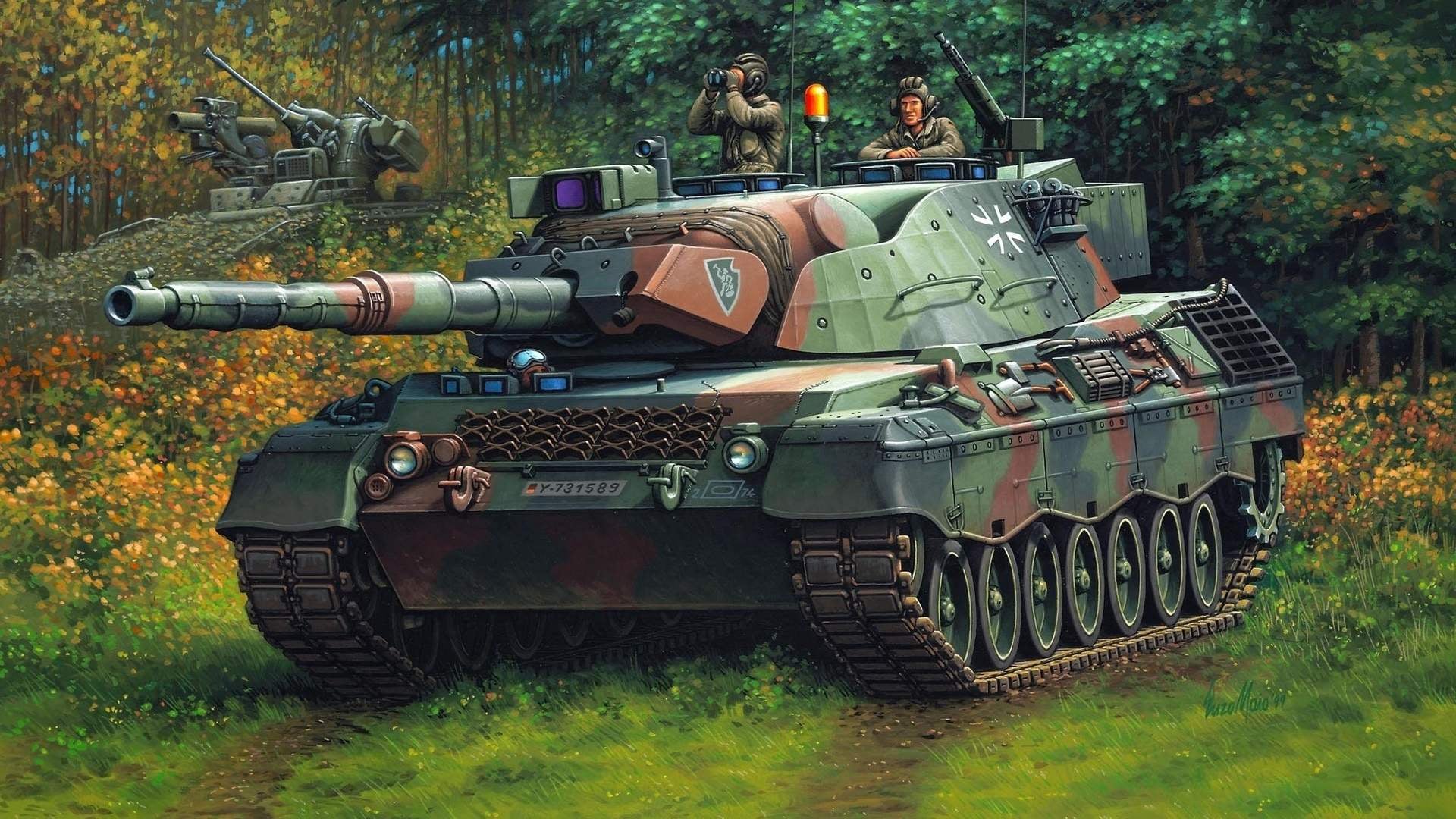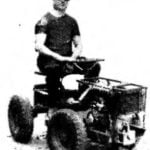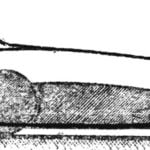 Since the emergence of tanks as a kind of weapon in their design a special mark was put “duel armor and shells”. By the end of the Second world war, showed a certain balance. One of the original criteria in the development of new war machines was the requirement that the tank armor is not penetrated by armor-piercing projectiles of his own gun. In this approach, and were all post-war tanks of the so-called first generation.
Since the emergence of tanks as a kind of weapon in their design a special mark was put “duel armor and shells”. By the end of the Second world war, showed a certain balance. One of the original criteria in the development of new war machines was the requirement that the tank armor is not penetrated by armor-piercing projectiles of his own gun. In this approach, and were all post-war tanks of the so-called first generation.
However, in the early 1950-ies there were serious doubts about the correctness of this approach. They were linked with the advent of anti-tank guided missiles — ATGM. It was in this period was created the most massive ATGM first generation Swiss “Cobra” and the French SS-10 and SS-11. They were portable and mounted on vehicles, light armored vehicles and helicopters. And although the system control-by-wire was, by modern standards, is very imperfect, however, allowed to hit the most protected tank in the range of 2-2. 5 km — distance absolutely prohibitive for armor-piercing and cumulative tank shells and anti-tank guns. That is why the military three European countries — Germany, France and Italy — came to the conclusion that in such circumstances, the tank is much more important to have a not so much powerful armor protection, how much strong arming, high dynamic characteristics, as well as smaller as possible overall dimensions. With good maneuverability and low visibility had a special significance, because these two parameters were almost the sole, which gave the opportunity to protect yourself from getting anti-tank.
I must say that took place in the mid-1950s years in service of these American tanks M47 and M48 neither the one nor the other did not differ. On the agenda was a question of creating a new, “European” tank.
Technical requirements for the development of a single tank of NATO was published in Germany on 25 July 1956. In accordance with the vehicle weight was to be 30 tons, the specific power of 30 HP/ton, a cruising range of 350 km, width of machine is less than 3150 mm, and the weapons consist of 90-mm guns. Armor was supposed to protect from 20-mm shells at all ranges. Provided for the installation of multi-fuel engine, a system of protection against weapons of mass destruction and the use of a torsion bar or hydro-pneumatic suspension.
It soon became clear that to develop uniform instructions easier to conduct real design of the tank under a single program. Therefore, in 1957, Germany and France decided on the parallel development of two sample tanks. In 1963, before the comparative trials of German and French prototypes, Germany finally refused to cooperate with France In June 1963, a German tank called “Leopard 1” was adopted by the Bundeswehr. The General contractor for the release of a new combat vehicle became the Munich firm Krauss-Maffei AG. In addition, serial production was carried out at the plant of the company Khirr-Mak in Kiel. On these two enterprises in the period from 1965 to 1974 was made 4024 tank.
The basic model was produced from 1965 to 1970, four industrial lots, which had minor differences from each other. Features of the tank was a combination cast and welded turret mushroom-shaped (in cross section) casing, as well as the lack of a rotating commander’s turret. Instead, it was installed panoramic sight and observation devices on the perimeter of the commander’s hatch. The upper front hull plates had an inclination of 60° when the thickness of the armor of 70 mm. Relatively low silhouette (the height of the roof of the tower 2400 mm) hampered the discovery of the tank and increases its resistance to the shock wave of a nuclear explosion. The workplace of the driver was in the front right of the axis of the tank. To his left was placed a large part of the ammunition — 42 shots.
It should be noted that the final choice of tools for the “Leopard” was preceded by a long discussion. And the caliber of the guns ranged from 90 to 120 mm. In the end settled on 105-mm rifled gun L7A1 English, which at that time was already established on the English tank “centurion” and the American M60. So this choice fully meets the requirement of command of the NATO standardization of armaments of the countries-participants of the block. The unitary weight of the 105 mm shot allowed the loader to work at a pace close to the rate of loading the 90 mm cannon with a much higher damaging effect 105-mm projectile, compared with the 90-mm. Gun was fitted with a symmetric recoil devices and electro-hydraulic actuators guidance. The ejector, an eccentric mounted on the barrel of the gun to the high pressure of the powder gases, does not reduce the angle of reducing gun. The barrel had basharatyan pipe connection with the official part. With gun was paired 7.62-mm machine gun MG3. On the roof of the tower installed anti-aircraft machine gun of similar calibre, and it could be used as the turret for the commander hatch and the turret hatch for the loader. In the turret, on the sides, were installed four smoke grenade launchers. Ammunition of the tank consisted of 60 artillery rounds and 5500 rounds of machine guns.

Main battle tank “Leopard 1”:
1 — 105-mm gun L7А1; 2 — illuminator; 3 — air intake system GROOVE; 4 — cast tower; 5 — anti-aircraft machine gun MG3; 6 — smoke grenade; 7 — hatch fan; 8 — shopping for equipment; 9 — louver vozdukhovody; 10 — driving wheel; 11 — supporting the rink; 12 — hydraulic shock absorber; 13 — support roller; 14 — the mechanism of track tension; 15 — guide wheel; 16 — rear view mirror; 17 — periscopic panoramic sight; 18 — loophole stereoscopic rangefinder; 19 — recess coaxial machine gun; 20 — recess of the telescopic sight; 21 — tool box; 22 — drawer storage IR sight and lights; 23 — mount the gun in its stowed position
On “Leopard” was installed 10-cylinder V-shaped four-stroke liquid-cooled diesel MTU MB 838 CA-M500 with a capacity of 830 HP (610 kW) at 2200 rpm engine capacity was 37 330 cm3. In the same block with them mounted dual flow hydromechanical transmission ZF4HP-250, consisting of a one-pot comprehensive hydraulic transmission with clutch lock-up, auto planetary gear box (4+2) and the rotation mechanism of the differential type. The total weight of the block engine-TRANS-mission — 4600 kg Block is attached to the hull with four bolts. With the help of a crane he could be replaced by the crew of the tank in about 20 minutes. Fuel consumption was 165 litres per 100 km. the Engine could run on diesel fuel, aviation kerosene or gasoline with an octane rating of 92.
The engine allowed a 39.6-ton combat vehicle (try to meet the challenge of Tejada-tion 30 and even 35 t and failed) to reach a maximum speed of 62 km/h, to overcome the angle of 31°, a trench width of 3 m, a wall height of 0.95 m and Ford to a depth of 2.2 m.
Chassis “Leopard” consisted of seven dual rubber rollers on Board, four single rubber-coated rollers, drive sprocket at rear with removable ring gear and guide wheel, interchangeable with the road wheels. Suspension individual torsion bar with telescopic hydraulic shock absorbers at 1-, 2-, 3-, 6- and 7th hardpoints. Caterpillar D-grade 139А2 cycloid gear, had a rubber-metallic hinges parallel type and removable rubber cushions.
The crew consisted of four people. The tower housed three crew members: the commander and gunner on the right of the gun, and charging — left.
For firing of the gun used in the optical stereoscopic rangefinder THE 2A combined with binocular gunner’s sight, monocular telescopic articulated auxiliary sight TZE 1A and panoramic periscopic monocular sight commander with a night under-cvetochniy channel. The optical head of the scopes were equipped with shutters, which automatically close for 0.25 s before the shot, thus eliminating the blinding of the gunner and commander from the flash shots, which is especially important when shooting at night. The fire control system includes an electronic ballistic computer.

Main battle tank “Leopard 1А4”:
1 — 105-mm gun to the insulation case; 2 — commander’s combined panoramic periscope sight PERI-R12; 3 — valve fan-cooled; 4 — welded tower; 5 — louver vozdukhovody; 6 — the rubber gunwale
In addition, the Leopard was fitted with a filtration-ventilation installation, air conditioning system, navigation equipment, automatic sprinkler system and a heater for the crew. Communications consisted of VHF radios SEM 70 and the internal communication device.
Since 1967, the car was produced in a modernized version of “Leopard-1A1” and the previously released tanks were brought up to his level. In the course of modernization were installed two-plane stabilizer of the American firm Cadillac Gage, the insulating cover of the barrel of a gun, rubber side skirts, caterpillar D 640A with removable rubber cushions and the automatic engine. In addition, the machine was equipped with equipment scuba driving, allows you to overcome along the bottom of water obstacles to a depth of 4 m. the Combat weight of the tank increased to 41.5 T.
“Leopards” fifth series, released in 1973, received the designation A2. 232 tanks of this modification was enhanced by the booking of the tower; installed BES-podsvetochnogo night vision of the driver and the commander; more efficient engine air cleaner; improved HLF.
The last tanks 110 fifth series, left the factory shops in 1973-1974, were installed welded turret with spaced armor and a wedge-shaped mask new guns, which allowed to increase the security of “Leopard” in the frontal projection to the level of security of an American tank M60A1. The need for such increased armor protection was elicited during study in Germany experience the Arab-Israel-tion of the 1973 war. It was then that the German tank builders realized that pretty hurried, “burying” armor protection.
As it turned out, tanks are still the main enemy was the tanks, and protection of combat vehicles in these conditions were no less important than weaponry and mobility. However, the massive and successful application of Egyptians anti-tank during the tank battles in the Sinai Peninsula were forced to more actively seek protection from them. The war machines began to ustanavlivatsya screens, dynamic protection, active use of layered and spaced booking.
Tanks modifications “Leopard 1А4”, formed the sixth batch, received the United MSA, which included the commander’s combined day/ night periscopic panoramic sight PERI-R12 stabilized line of sight, optical stereoscopic sight-rangefinder EMES-12A1 (without laser parts) and electronic ballistic computer FLER-H. For the Bundeswehr was made 250 combat vehicles this modification. The production of tanks “Leopard” for the German army ended. It is time for upgrades.
The first and most global modernization became associated with the strengthening of bronta-shields tanks “Leopard 1A1”. On all the machines 1845 this version had additional armor protection tower company Blohm und Voss. Screens with a thickness of 20-30 mm was mounted on the bonok at some distance from the tower. The result was posted to the reservation, roughly equivalent to that used in the turret modifications A3 and A4. The combat weight of the tank received index “Leopard 1А1А1”, amounted to 42.4, etc
All subsequent modernization of the “leopard” of different modifications were not as significant. Combat vehicles equipped with thermal imaging system of observation and aiming PZB 200 and the new SEM 80/90 radio station. In 1986, was developed by modification of the “Leopard 1А5”, which until 1992 was altered 1225 tanks the first five series, with the aim of extending their life up to the beginning of the XXI century. These machines equipped with FCS EMES-18 and a gunner’s sight with integrated laser rangefinder and TEP-Louisiana channel, put the advanced gun stabilizer.

Regarding military service, the first production of the “leopard” arrived in 1966, battalions of the 1st army corps of the Bundeswehr. All in all, from 1966 to 1974, the army of Germany was transferred 2437 combat vehicles of this type.
Since the late 60-ies of the “Leopard” in fact became the standard NATO tank. In December 1967, 334 tank ordered the armed forces of Belgium. 1991-1996 132 of them were upgraded to the level of “Leopard 1А5”. In 1968-1970 78 tanks were delivered to Norway. Subsequently, the country received 92 “Leopard”. Recently some of the tanks are also upgraded to the A5 standard. The armament of the land forces of the Netherlands in 1969-1971 received 468 tanks “Leopard 1NL”. Some of them were released on the German license by the Dutch company DAF. In the mid 80-ies of these tanks were upgraded: installed JMA Honeywell/Zeiss 12АЗ AFSL-2, rifle scope Zeiss EMES-12 with built-in laser rangefinder and armour of the tower. Machine received the designation “Leopard 1V”.
And between 1970 and 1985 in the Italian army received 920 tanks “Leopard”. 200 of these units produced firm Krauss-Maffei AG, and 720 — Italian firm OTO-Melara. In the early 90-ies of the 120 tanks were modernized to the standard A5. 1976-1978 120 cars “Leopard 1 A3” set in Denmark; later they were joined by 110 tanks “Leopard 1А4”. Since August 1993, a programme of modernization of these tanks.
Greece ordered 108 tanks modification A3 in the spring of 1981. The programme of military assistance to the Greeks received 75 cars variant of the A5 at the end of 1988 and in the mid 90-ies 150 tanks “Leopard 1V” from Holland.
1976-1978 103 of the tank “Leopard 1АЗ” did Australia. They were fitted with the Belgian SABCA FCS and the systems that ensure operation of the tank in the South. These machines armed with the 1st tank regiment, stationed in the province of Victoria.
The canadian army has adopted the 114 tanks “Leopard 1АЗ” (canadian designation “Leopard 1S”), the Canadian tanks were different from the German fire control system, lighting equipment, radio equipment and machine guns. 77 tanks were in service with the 4th mechanized brigade, stationed on the territory of Germany.
Under the program of military aid 77 “leopards 1АЗ” in 1982-1983 went to Turkey. In the late 80-ies of the Turks was transferred to 250 tanks “Leopard 1А4”, and in the beginning 90-x — 80 “leopards 1А5”.
Operated in Germany in the 60-80-ies of the laws restrict the export of military equipment on the territory of NATO, and without resale rights. The only supply outside of the unit was made in Australia. In the 90-ies, in connection with the removal of the “Leopard 1” armament of many NATO countries, increased its deliveries to third countries.
As of January 1, 2000 tanks “Leopard 1” of various modifications were in service with Greece and the Netherlands, and Australia (71 units), Belgium (155), Brazil (87), Germany (1315), Denmark (220), Italy (868), Canada (114), Norway (170), Turkey (397) and Chile (67).
“Leopards” never participated in combat. As part of the Danish contingent used only in the peacekeeping operation in Bosnia.
On the basis of the base chassis was created several combat and support vehicles. Including BRAM BPz-2 standard and the BPz-2A2, sapper tanks 1 and Pionierpanzer Dachs, vehicle-launched bridge Biber, Gepard, ZSU.
Foreign second generation of tanks “Leopard 1” had the best features because of its low silhouette and good for 60 years the level of mobility. During the development of the tank in Germany was reconstituted, research, design and then the production base of tank. Held 70 years of modernization have increased the level of protection of the tank, but he was unable to meet the increased demands of the late 70-ies and as a result was replaced by a new third generation tank “Leopard 2”.
M. BARYATINSKY



